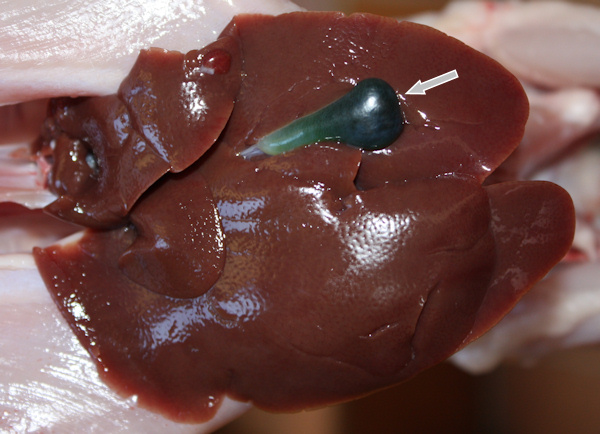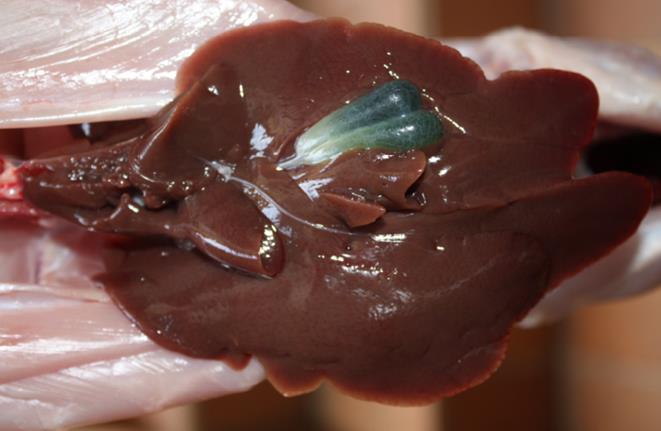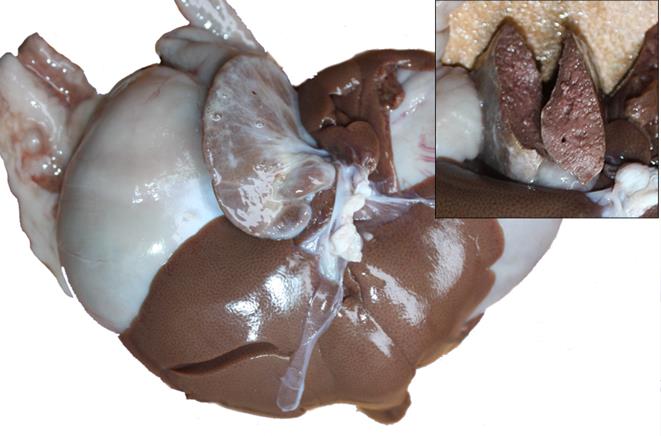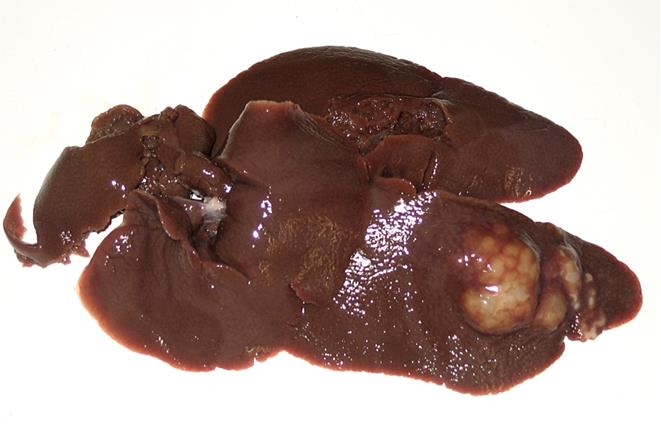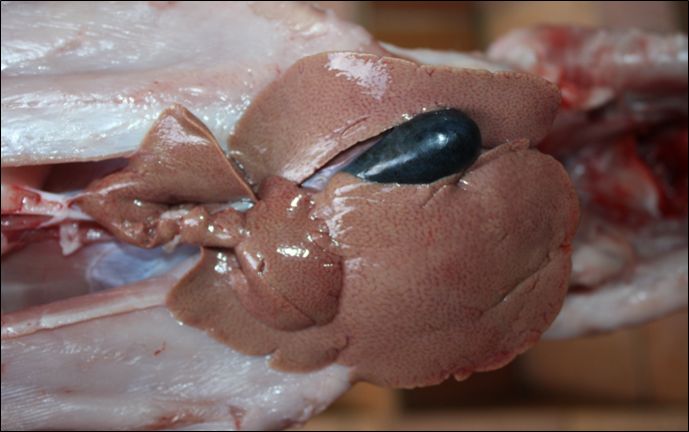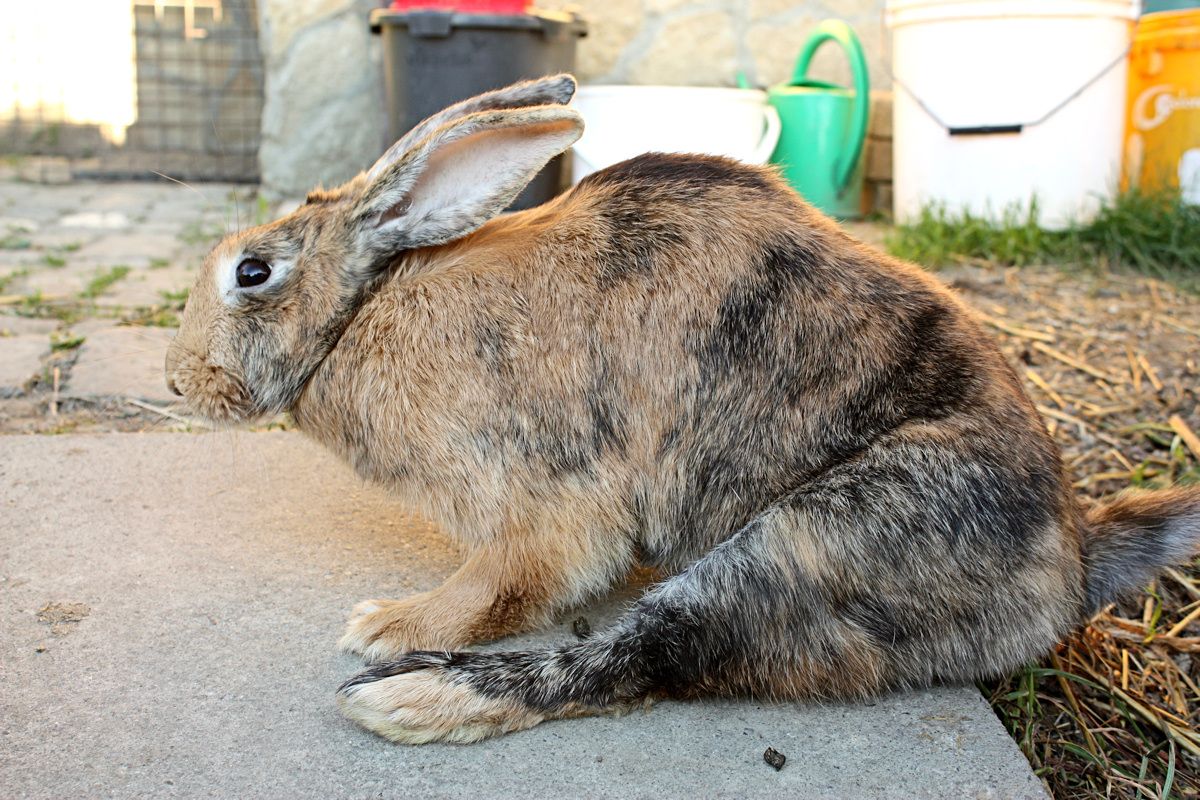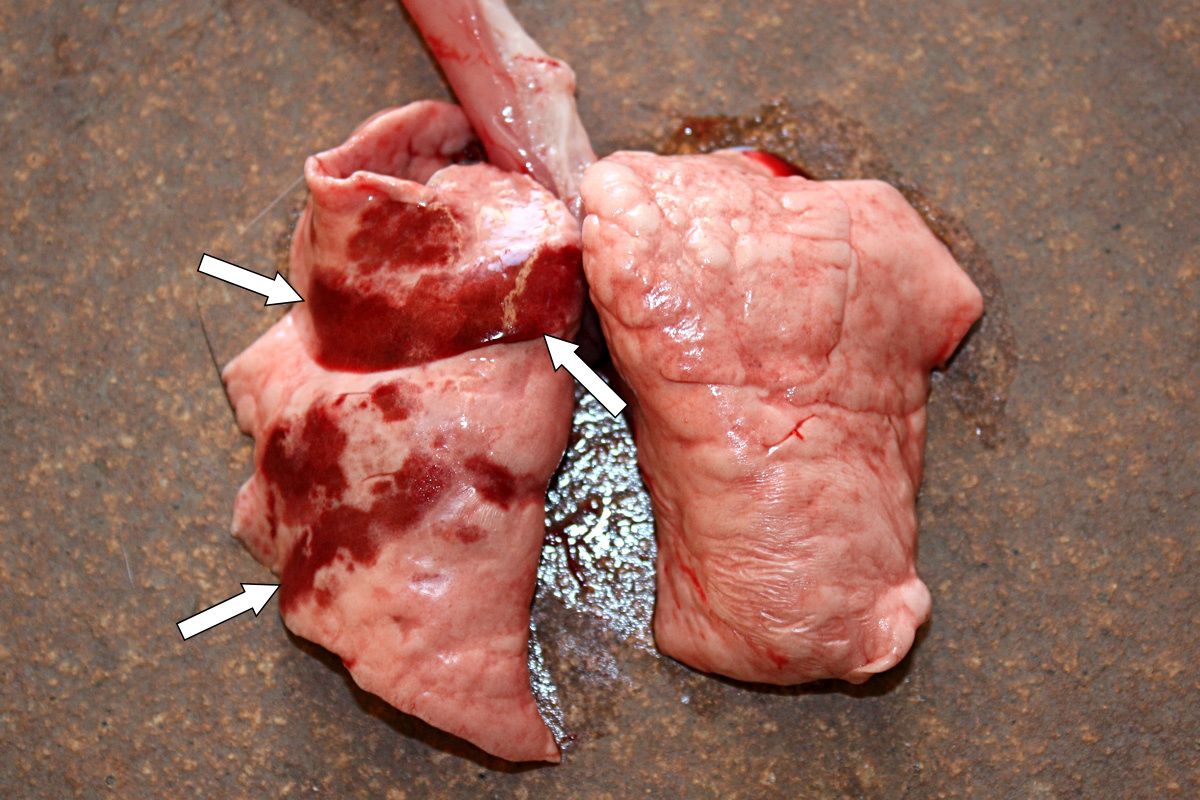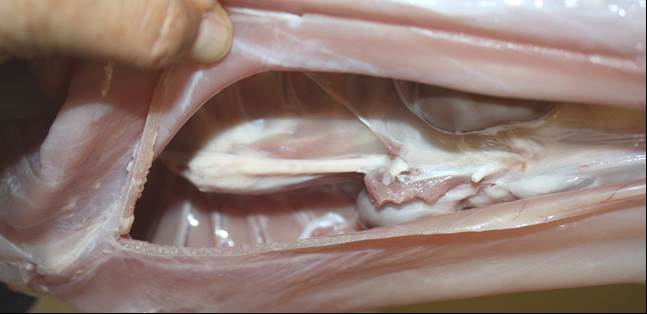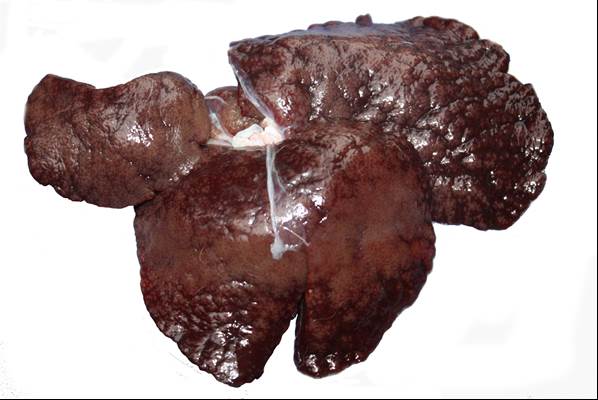The liver, a
delicate organ in rabbits
Michel
Gruaz -
Esther van Praag, Ph.D.
|
MediRabbit.com is funded solely by the
generosity of donors. Every donation, no matter what
the size, is appreciated and will aid in the continuing research of medical
care and health of rabbits. Thank you
|
|
The liver is a large organ that
occupies a big part of the rabbit's abdomen. Its surface is homogeneous, with
a red-brown color. The liver has endocrine as well as exocrine functions,
with the secretion of bile. The liver of rabbits has 2
major lobes, right and left, which are separated by a median fissure in
between them, in which the accessory lobes are located: the caudate lobe and
the square lobe. The liver is maintained in place in the abdominal cavity by
ligaments connected to the diaphragm and to the dorsal wall of the abdomen.
The liver plays a central role in the synthesis of proteins, in the
metabolism of sugars and the storage of nutrients, in the degradation of
toxins and the treatment of organic waste produced by cells of the body. It
has, furthermore, an exocrine function with the secretion of bile. This
balance can be broken during a disease, the presence of bacteria, parasites
or toxins in the diet. Liver disorders are poorly recognized in rabbits because
the clinical manifestations are vague and not very characteristic. Single
and double gall bladder The gall
bladder is a hollow, pear-shaped organ that lies against the liver in the
caudal surface depression. It produces bile, a viscous yellow-greenish liquid
that is released into the small intestine via the bile duct. This secretion
promotes the digestion of fatty foods. In rabbits, bile is produced
continuously and is stored in the gallbladder before its release into the
small intestine. Bile of rabbits is mainly composed of biliverdin,
which has strong antioxidant properties, and not bilirubin. The quantity of
bile produced by this animal per day is enormous: about 250 ml. Based on
weight, this is 7 times the amount produced by a dog.
Normal
rabbit liver and gallbladder (arrow) A double
or bilobed gall bladder is a rare observation.
The duplication of the gallbladder takes place during the embryonic phase.
The gallbladder is subdivided, and results in two complete vesicles of normal
size and volume. Their respective ducts transport bile to the intestine.
These ducts can merge halfway or remain separate. The duplication of the
gallbladder seems to affect herbivores more than carnivores or man: 1 case
out of 28 in cattle and 1 case out of 85 in sheep. Some cases have been
reported in rabbits too. Various clinical manifestations are associated with
this congenital anomaly: pain and loss of appetite. In other animals, a
duplicate gall bladder is often associated to biliary colic, acute
inflammation of the gallbladder or the presence of gallstones.
Michel
Gruaz Liver and double
gallbladder (pocket filled with green liquid - arrows) in a Harlequin rabbit
aged 3 months. Since weaning, this rabbit had regular digestive problems and
weighted only 2.3 kilos, while his littermates weighed 2.8 kg. Liver
lobe torsion The torsion of a lobe of the
liver is a sporadic (non-hereditary) event whose cause is not well clarified.
Most likely it seems linked to an abnormal dilatation of the stomach and
intestine after an intestinal obstruction. Ligaments holding the liver in
place in the abdomen are distended and weakened, allowing the twisting of a
lobe. Other causes include external trauma, bacterial or parasitic infection,
or congenital absence of ligaments. A predisposition has been suggested in
Madagascar lop rabbits. But this remains to be verified as the line of
affected rabbits could not be established. Gestation is not a cause of
hepatic lobe torsion in rabbits or other animals. In 63% of cases, torsion of the caudate lobe is
observed in rabbits. This lobe is attached to the liver on a very small surface
only, facilitating its movement in the abdominal cavity or its torsion. Blood
circulation is then hindered, causing atrophy of the lobe. Its consistency
becomes hard and it takes a dark color. The condition is painful and leads to
decreased appetite, shock and death after a few days. If the lobe ruptures,
the resulting hemorrhage causes death quickly. A minority of rabbits survive
when they receive supportive care consisting of oral food assistance with a
syringe, sterile subcutaneous fluids, analgesic, antimicrobial/anticoccidial, and other intestinal motility drugs (1 to
2 cc of olive oil is effective too).
Michel
Gruaz Liver with torsion of
the small caudal lobe and content of the caudal lobe. Bacteria, coccidia
and parasites Bacteria can invade the liver
and cause abscesses. The most common bacteria are Pasteurella sp. or Escherichia
coli. When in contact with birds or cattle, the rabbit's liver can also
be infected with salmonella, listeria or Yersinia sp., which causes
pseudotuberculosis. As for the parasitic protozoa infecting the rabbit's
liver, they include those causing coccidiosis (Eimeria
stiedae) and toxoplasmosis. Coccidiosis affects
young animals. Their digestive system is particularly sensitive to this
parasite during the food transition from milk to vegetable food, which is
more difficult to digest. Signs of infection include a decreased appetite,
diarrhea, mucus between hard droppings, weight loss, and death. The young
rabbit often has a swollen belly. Older and healthy rabbits develop some
immunity against this parasite. Examination of the liver reveals the presence
of yellow-colored nodules on the surface that are difficult to differentiate
from a bacterial abscess.
Michel
Gruaz These white structures
are difficult to differentiate between abscess and coccidia.
Parasitic worms of the liver
are rather occasional in rabbits, after ingestion of food contaminated by
snails, dogs or foxes. The rabbit does not host the adult parasite, but an
intermediate form. These are mainly the great liver fluke (Fasciola hepatica) present in the
grasslands, dog
tapeworm (Taenia sp.) and the fox worm (Echinococcus multilocularis).
The two latter form hydatid cysts containing the larvae of the parasite.
These cysts can take a certain volume in the abdomen and compress the
rabbit's liver. Few clinical signs indicate the presence of these worms in
live rabbits. Toxemia and liver lipidosis Pregnancy
toxemia is a serious disorder caused by a disruption of the energy metabolism
in the late gestational rabbit. Intrauterine growth of fetuses requires a lot
of energy. If this demand is not met with a high-calorie diet, the blood
glucose level of the doe drops rapidly. The adipose tissues are mobilized and
start to release fats into the blood, poisoning the body. The liver does no
longer functions properly and does not eliminate ketone bodies. Other vital
organs are also affected, like the kidneys. The pH of the urine decreases
(5-6), its color is clear and it is low in sediments, but it contains ketones
and proteins. The intestinal transit is decreased or even stopped. The
occurrence of diarrhea and/or a decrease in the amount of produced droppings
are common. At autopsy, organs such as the liver, thyroid, heart, kidneys and
adrenal glands are very pale. These organs may have greasy infiltrations and
necrotic foci. The stomach contains only a little food. Hemorrhages are
visible in the placenta and uterus. Another consequence of a difficult
gestation or lactating of a large litter is hepatic lipidosis.
The alternation of feeding followed by refusal to eat causes an accumulation
of fats in the liver and kidneys of the doe. Their functioning is altered.
The rabbit eats less and less, becomes lethargic and loses weight. Other causes of liver lipidosis
include dental problems or a diet low in fiber. Rabbit obesity is also
characterized by an abnormal accumulation of fat in liver cells linked to a
diet that is too rich in sugars (and not in lipids). Instead of metabolizing
them and removing excess, the liver stores lipids in its tissues.
Michel
Gruaz Pale liver in a doe that
died from gestation toxemia. Toxins,
gas fumes and pesticides Various toxins affect the
rabbit's liver and alter its functioning. Aflatoxin of fungal origin is
contained in cereals contaminated by molds. It is very toxic to the liver and
can lead to death quickly. Plant toxins are suspected of causing neurological
problems such as the head
down syndrome. The rabbit keeps its head down, unable to raise it, keeps
its back arched and often refuses to move and to feed itself.
The severity varies from case to case. Some rabbits recover after a few days while
others do not survive. Lead and heavy metals also cause serious dysfunction
of the liver. The use of pine sawdust or cedar, vermiculite should be avoided
in a cage or a hutch, even if their smell is pleasant. Indeed, the emanations
of these products have a toxic effects on the liver.
Pesticides
affect the nervous system, with signs of hyperactivity, hypersensitivity
and/or paralysis accompanied by breathing difficulties, diarrhea, hypothermia
and/or nasal bleeding. Younger rabbits are more sensitive and more affected
than adults. The general state of health and nutrition of the animal also
plays a role. Treatment is essentially supportive, helping the rabbit with
assisted syringed food and fluids to prevent dehydration. Autopsy of
intoxicated rabbits shows that the liver has a pale
color with cellular hypertrophy and fatty degeneration. These disorders often
precede the coma and death of the animal.
Typical
hunched position of a female rabbit, with paralysis of the hind-limbs, after
a pesticide intoxication.
Lungs
of the above rabbit, showing multifocal hemorrhagic regions (arrows) in the
lungs. Deformation of the spinal cord A less common cause of liver disease is bone
deformity of the spine, such as lordosis, which is observed sporadically
in rabbits. The curvature of the spine towards the inside of the abdomen
causes pressure on the abdominal mass and compression of the blood vessels
draining the blood from the heart to the organs and vice versa. Liver
and kidneys are mainly affected. In the liver, blood flow from the inferior vena
cava is restricted, resulting in a reduced hepatic activity. The
secretion of bile into the intestine is decreased, leading to a poor
digestion of the ingested food. As a result, toxins accumulate in the liver,
which takes a congested appearance, with a dark red color, a size slightly
larger than normal, and rounded and rough edges. Passive congestion of the
liver may be secondary to heart failure.
Michel
Gruaz Incidetal
finding upon necropsy: lordosis of the spine (arrow) and congested liver in a
young Champagne Silver rabbit. The spinal deformation is accompanied by liver congestion, a possible
consequence of compressed blood vessels from the heart to this organ. Finally, the rabbit's liver can
develop cancerous tumors or bile duct tumors. Liver diseases are so numerous
and often difficult to detect in rabbits. Indeed, signs are not very
characteristic in addition to the fact that the rabbit has a tendency to hide
the presence of a disease. Remains the observation: droppings, their smell
and shape, the presence of mucus, amount of water drunk, in addition to
veterinary tests to establish more precisely a liver disease. Further informationCere N, Humbert JF, Licois D, Corvione M, Afanassieff M, Chanteloup N. A
new approach for the identification and the diagnosis of Eimeria
media parasite of the rabbit. Exp Parasitol. 1996; 82(2):132-8. Cox JC, Edmonds JW, Shepherd RC. Toxoplasmosis and the wild rabbit Oryctolagus cuniculus in Victoria, Australia with suggested mechanisms for dissemination of oocysts. J Hyg (Lond). 1981;87(2):331-7. Coudert P., Licois D., Drouet-Viard F., Provôt F. 2000. "Coccidiosis". In: Rosell J.M. (ed), (Enfermedades del conejo), vol.II, chapter XVI, pp 219-234, Mundi-Prensa Libros, Madrid, Spain. Dubey JP, Passos LM, Rajendran C, Ferreira LR, Gennari SM, Su C. Isolation of viable Toxoplasma gondii from feral guinea fowl (Numida meleagris) and domestic rabbits (Oryctolagus cuniculus) from Brazil. J Parasitol. 2011;97(5):842-5. Grabarczyk M, Kopeć-Szlezak J, Szczepańska I, Woźniak J, Podstawka U. The effect of gamma-hexachlorocyclohexane (lindane) on blood cells, kidney and liver tissues in rabbits. Haematologia (Budap). 1990;23(3):171-9. Gustafsson K, Uggla A, Järplid B. Toxoplasma gondii infection in the mountain hare (Lepus timidus) and domestic rabbit (Oryctolagus cuniculus). I. Pathology. J Comp Pathol. 1997a;117(4):351-60. Kopeć-Szlezak J, Góralczyk
K, Woźniak J. Changes in serum
and internal organs during increased accumulation
of gamma-hexachlorocyclohexane in adipose tissue of rabbits.
Mater Med Pol. 1989 Oct-Dec;21(4):286-91. Licois D, Coudert
P, Bahagia S, Rossi GL. Endogenous development of Eimeria intestinalis in rabbits. J Parasitol. 1992; 78(6):1041-8. Manning et al. The biology of the
laboratory rabbit. 2nd ed. London, UK, 1994. Milot L, Partensky
C, Scoazec JY, Valette PJ, Pilleul F. Double gallbladder diagnosed on
contrast-enhanced MR cholangiography with mangafodipir trisodium. AJR Am J Roentgenol. 2005;184(3
Suppl):S88-90. Moores AL, Gregory SP. Duplex gall
bladder associated with choledocholithiasis,
cholecystitis, gall bladder rupture and septic peritonitis in a cat. J Small Anim Pract. 2007;48(7):404-9. Palmer AK, Bottomley AM, Worden
AN, Frohberg H, Bauer A. Effect of lindane on pregnancy in the rabbit and rat. Toxicology.
1978 Mar;9(3):239-47. Pakandl M, Drouet-Viard
F, Coudert P. How do sporozoites
of rabbit Eimeria species reach their
target cells? C R Acad Sci
III. 1995; 318(12):1213-7. Stingl H. Vesica fellea
duplex and vesica fellea
divisa in rabbits (Oryctolagus cuniculus). Berl Munch Tierarztl Wochenschr.
1971;84(21):420-2.
Stolkind E. Double gall-bladder report of a case and review of 38 cases. British Journal of
Surgery Vol 27 (108), 1940: 760–766.
|
e-mail: info@medirabbit.com



